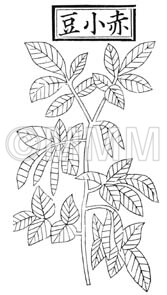※Click on the image to enlarge it.
| Common name | 赤小豆, Chixiaodou, Vignae Semen (CP2020), Rice Bean (CP2020) |
|---|
| Original plant name | Vigna angularis Ohwi et H. Ohashi (= Phaseolus angularis Wight) or Phaseolus calcaratus Roxb., (Azuki) |
|---|
| original plant image |  |  |
※Click on the image to enlarge it. |
|
|---|
| Family name | Leguminosae |
|---|
| Used part | mature seed |
|---|
| Quality for selection | For medicinal use, fresh, small sized and wine-colored shiny one is good. (NI) |
|---|
| Official compendium | CP (2020 ed.) |
|---|
| Clinical application | As an antidote and diuretic, Chixiaodou is applied for dropsy, beriberi, diarrhea and carbuncles. It is used as food. |
|---|
| Medical system | Traditional Chinese medicine |
|---|
Drug effect in
traditional medicine | Traditional
classification | Diuretics removing dampness |
|---|
| Beneficial effect | [Property and Flavor] Neutral; sweet and sour.
[Meridian Tropism] Heart and small intestine meridians.
[Actions] To promote urination to alleviate edema, remove toxin and expel pus.
[Indications] Edema distention and fullness, beriberi and edema, jaundice with red urine, wind-dampness heat impediment, swelling abscess, sore and toxin, intestinal abscess with abdominal pain. |
|---|
| Chemical constituent | Sterols
(*C1):
Phytosterol
Isoflavones
P. vulgaris (*C1):
Phaseollidin, Phaseollin
Others
(*C1):
結晶性サポニン I, 結晶性サポニン II, 結晶性サポニン III, 色素 / Crystalline Saponin I - III, Pigment
|
|---|
| Pharmacological effect | Not exactly known. |
|---|
| DNA sequence | Y19426,Y19462 |
|---|
Classical reference
(Chinese Herbal Classic "Zhenglei bencao") |  ※Click this image to see the actual image ※Click this image to see the actual image |
|---|
| Disease | Edema, Oliguria, Jaundice, Intestinal purulent inflammation, Bleeding hemorrhoids, Pyogenic dermatosis |
|---|
| Formulation | Maorenshosekishozuto, Sekishozuto |
|---|
| References | CP2020: Pharmacopoeia of the People's Republic of China 2020 edi.
C1) The Encyclopedia of Wakan-Yaku with Color Pictures Vol. I, pp 293-294. |
|---|
| Remarks | Many species are grown in Japan. Owariazuki (Chokan'azuki) and Akiazuki are the best quality for medicinal use, followed by Natsuazuki and Ōazuki (Dainagon). |
|---|
| Last renewal date | 2021/09/27 |
|---|
| | |
|---|